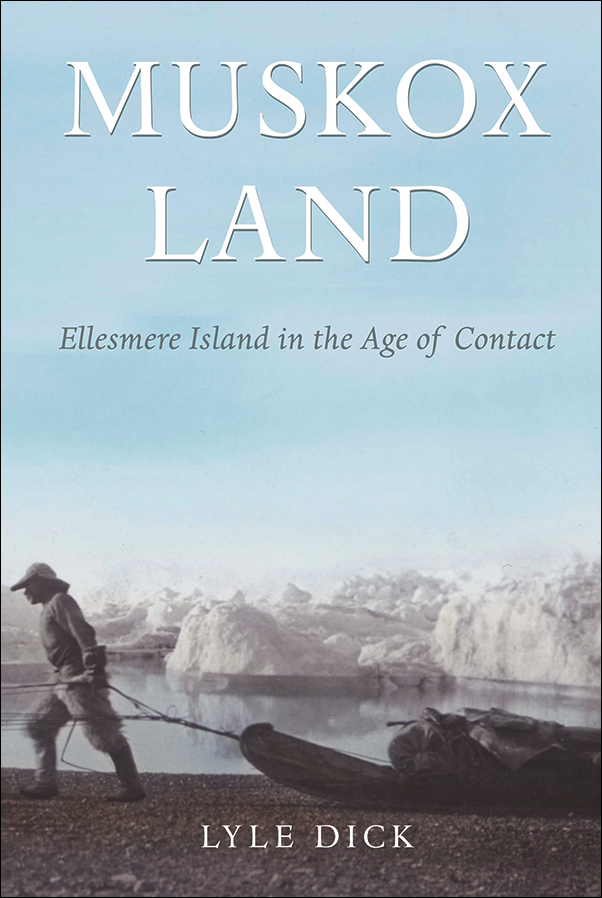
Muskox Land: Ellesmere Island in the Age of Contact
Lyle Dick
$34.95 CAD / $39.95 USD
631 pages, 97 illustrations
6 x 9 inches
978-1-55238-050-5 (Paperback)
978-1-55238-412-1 (Institutional PDF)
January 2001
About the Book
Critical forces of culture and nature collide in this comprehensive history of Ellesmere Island in the age of contact, winner of the Harold Adams Innis Prize from the Federation for the Humanities and Social Sciences.
Surveying the nineteenth and early twentieth centuries, Lyle Dick presents an impressive treatment of European-Inuit contact in the High Arctic (the area of what is now the Quttinirpaaq National Park) while considering the roles of the natural environment and cultures as factors in human history. As he charts the dynamic interplay between change and continuity in this forbidden land, Dick unravels the complexities of cultural exchange and human relationships to the Arctic landscape.
Muskox Land provides a meticulously researched and richly illustrated treatment of Canada’s High Arctic as it interweaves insights from historiography, Native studies, ecology, anthropology, and polar exploration. Winner of the Harold Adams Innis Prize for Best English Language Book in the Social Sciences, Canadian Federation for the Humanities and Social Sciences.
About the Author
Lyle Dick is the West Coast Historian for Parks Canada and president of the Canadian Historical Association. He has published extensively in the fields of Arctic history, western Canadian history, and historiography. Lyle Dick has also received numerous awards for endeavours and accomplishments in his chosen fields.
Praise for Muskox Land
The broad sweep of this book is most impressive, and the scholarship is outstanding . . . [it] is a treasure trove of information, and it is strongly recommended that it should be read—and read again—by all interested in the Canadian Arctic in general and in its Native people.
—G. Hattersley-Smith, Arctic
A significant contribution to Arctic history and anthropology . . . The inclusion of aboriginal voices to the pre-eminent Euro / American / Canadian histories is a welcome reprieve
—Chris Paci, Études/Inuit/Studies
Muskox Land is a sprawling, impressive contribution to the understanding of northern Canadian history. Prepared with a sharp eye for contemporary historiographical trends and abundant narrative detail, this study of Ellesmere Island provides an unusually rich and complex description of the evolution of human activity in a part of the country that few Canadians give more than a passing thought
—Ken Coates, The Canadian Historical Review
There is no other work which delves with such depths into this subject. Muskox Land is a must for anyone who has every visited or worked in the Eastern High Arctic
—Richard Riewe, University of Manitoba
Table of Contents
Figures
Acknowledgements
Notes on Orthography and Terminology
Introduction
Part One – CONTINUITY: The Natural Environment, Culture, and Human History
Geography and Climactic History of Ellesmere Island
High Arctic Ecosystems and Human History
Inughuit Culture in the High Arctic, 1800-1900
The Inuit on Ellesmere Island and Exchanges with the Inughuit in the Nineteenth Century
European Cultures in the High Arctic 1818-1940
Part Two – CIRCUMSTANCE: History of Events on Ellesmere Island, 1818-1940
Early Exploration of the High Arctic by Europeans, 1818-1940
"Mine at Last:" Robert E. Peary’s Polar Expeditions, 1890-1909
Assertion of Canadian Soverigenty over the High Arctic, 1985-1940
Adventures, Big-Game Hunters, and Scientists on Ellesmere Island, 1934-40
Part Three – CHANGE: The Interplay of Cultures and the Environment 1818-1940
Material and Technological Adaptations of the Contact Era
Intercultural Relations in the Contact Era
Cultural Contact and High Arctic Ecology, 1818-1940
Part Four – CIRCUMSTANCE, CHANGE, AND CONTINUITY: Inuit on Ellesmere Island, 1950-2000
Circumstance: Relocations of the Inuit to the High Arctic, 1950-2000
Change: Adaptation to New Natural and Cultural Environments, 1951-2000
Continuity Reasserted: Inuit, the Seasons, and the Land, 1951-2000
Conclusion: Ellesmere Island and the Times of History
Photographs
Notes
Bibliography
Index
Table of Contents
Figures
Acknowledgements
Notes on Orthography and Terminology
Introduction
Part One – CONTINUITY: The Natural Environment, Culture, and Human History
Geography and Climactic History of Ellesmere Island
High Arctic Ecosystems and Human History
Inughuit Culture in the High Arctic, 1800-1900
The Inuit on Ellesmere Island and Exchanges with the Inughuit in the Nineteenth Century
European Cultures in the High Arctic 1818-1940
Part Two – CIRCUMSTANCE: History of Events on Ellesmere Island, 1818-1940
Early Exploration of the High Arctic by Europeans, 1818-1940
"Mine at Last:" Robert E. Peary’s Polar Expeditions, 1890-1909
Assertion of Canadian Soverigenty over the High Arctic, 1985-1940
Adventures, Big-Game Hunters, and Scientists on Ellesmere Island, 1934-40
Part Three – CHANGE: The Interplay of Cultures and the Environment 1818-1940
Material and Technological Adaptations of the Contact Era
Intercultural Relations in the Contact Era
Cultural Contact and High Arctic Ecology, 1818-1940
Part Four – CIRCUMSTANCE, CHANGE, AND CONTINUITY: Inuit on Ellesmere Island, 1950-2000
Circumstance: Relocations of the Inuit to the High Arctic, 1950-2000
Change: Adaptation to New Natural and Cultural Environments, 1951-2000
Continuity Reasserted: Inuit, the Seasons, and the Land, 1951-2000
Conclusion: Ellesmere Island and the Times of History
Photographs
Notes
Bibliography
Index
Awards
WINNER, FHSS Harold Adams Innis Prize | 2002